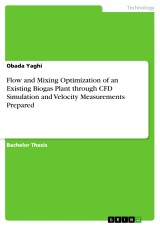Details

Flow and Mixing Optimization of an Existing Biogas Plant through CFD Simulation and Velocity Measurements Prepared
1. Auflage
|
36,99 € |
|
| Verlag: | Grin Verlag |
| Format: | |
| Veröffentl.: | 17.04.2019 |
| ISBN/EAN: | 9783668925748 |
| Sprache: | englisch |
| Anzahl Seiten: | 95 |
Dieses eBook erhalten Sie ohne Kopierschutz.
Beschreibungen
Bachelor Thesis from the year 2016 in the subject Engineering - Mechanical Engineering, grade: 94%, German Jordanian University (hosted by Hamburg University of Technology), language: English, abstract: This research project enables further development and improvement of the mixing efficiency in an existing biogas plant, by utilizing CFD simulation as well as a newly developed flow sensor in addition to supportive laboratory tests. The flow was analyzed considering the following variables: The mixing time, the Dry Matter (DM) content, the positioning of the agitators and how it can be related to the amount of velocity dead-zones.
The velocity measurements took place at the biogas plant of the company Ardestorfer Bioenergie GmbH in the district of Buxtehude. The current plant capacity is approximately 1.6 MWel using animals manure, energy crops as well as agricultural residuals.
In order to be able to perform the CFD simulation, a complete 3D model had to be done of the examined fermenter and the mixing agitators. Moreover, the current setup including fluid properties, boundary and initial conditions had to be taken into consideration. Velocity measurements were used as a validation approach for the simulation results, furthermore to acquire an overview of the flow behavior over the investigated mixing period.
Firstly, it was found that at higher DM content the flow seemed to be more stable, and the velocity values get quite higher at the examined points. Moreover, at higher DM content (9.35% compared with 8.8%) the velocity dead-zones seemed to be approximately 70% less.
Secondly, another approach was considered to improve the mixing and to minimize the dead-zones by changing the position of the main agitator. The new scenario showed fewer dead-zones by approximately 65% according to the CFD model.
Thirdly, at all scenarios and setups, the flow seemed to reach the maximum possible velocity, and rather motion distribution after 150-180 seconds. Showing no remarkable improvement after this period.
The mentioned findings were concluded based on comparisons between different velocity measurements as well as CFD simulation results at different operating conditions and setups. Being able to offer proper recommendations for a better energy efficiency in terms of lower energy consumption and better mixing all over the fermenter.
The velocity measurements took place at the biogas plant of the company Ardestorfer Bioenergie GmbH in the district of Buxtehude. The current plant capacity is approximately 1.6 MWel using animals manure, energy crops as well as agricultural residuals.
In order to be able to perform the CFD simulation, a complete 3D model had to be done of the examined fermenter and the mixing agitators. Moreover, the current setup including fluid properties, boundary and initial conditions had to be taken into consideration. Velocity measurements were used as a validation approach for the simulation results, furthermore to acquire an overview of the flow behavior over the investigated mixing period.
Firstly, it was found that at higher DM content the flow seemed to be more stable, and the velocity values get quite higher at the examined points. Moreover, at higher DM content (9.35% compared with 8.8%) the velocity dead-zones seemed to be approximately 70% less.
Secondly, another approach was considered to improve the mixing and to minimize the dead-zones by changing the position of the main agitator. The new scenario showed fewer dead-zones by approximately 65% according to the CFD model.
Thirdly, at all scenarios and setups, the flow seemed to reach the maximum possible velocity, and rather motion distribution after 150-180 seconds. Showing no remarkable improvement after this period.
The mentioned findings were concluded based on comparisons between different velocity measurements as well as CFD simulation results at different operating conditions and setups. Being able to offer proper recommendations for a better energy efficiency in terms of lower energy consumption and better mixing all over the fermenter.
Diese Produkte könnten Sie auch interessieren:

Neutron Applications in Earth, Energy and Environmental Sciences

von: Liyuan Liang, Romano Rinaldi, Helmut Schober

149,79 €

Nanobioelectronics - for Electronics, Biology, and Medicine

von: Andreas Offenhäusser, Ross Rinaldi

96,29 €














